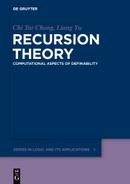Contents
Preface
Part I: Fundamental theory
1An introduction to higher recursion theory
1.1Projective predicates
1.2Ordinal notations
1.3Effective transfinite induction
1.4Recursive ordinals
1.5 -completeness and
-completeness and  -boundedness
-boundedness
2Hyperarithmetic theory
2.1H-sets and  -singletons
-singletons
2.2 -ness and hyperarithmeticity
-ness and hyperarithmeticity
2.3Spector’s Uniqueness Theorem
2.4Hyperarithmetic reducibility
2.5Some basis theorems and their applications
2.6More on 
2.7Codes for sets
3Admissibility and constructibility
3.1Kripke–Platek set theory
3.2Admissible sets
3.3Constructibility
3.4Projecta and master codes
3.5ω-models
3.6Coding structures
3.7The Spector–Gandy Theorem
4The theory of  -sets
-sets
4.1A  -basis theorem
-basis theorem
4.2 -uniformization
-uniformization
4.3Characterizing thin  -sets
-sets
4.4 -sets
-sets
5Recursion-theoretic forcing
5.1Ramified analytical hierarchy
5.2Cohen forcing
5.3Sacks forcing
5.4Characterizing countable admissible ordinals
6Set theory
6.1Set-theoretic forcing
6.2Some examples of forcing
6.3A cardinality characterization of  -sets
-sets
6.4Large cardinals
6.5Axiom of determinacy
6.6Recursion-theoretic aspects of determinacy
Part II: The story of Turing degrees
7Classification of jump operators
7.1Uniformly degree invariant functions
7.2Martin’s conjecture for uniformly degree invariant functions
7.3The Posner–Robinson Theorem
7.4Classifying order-preserving functions on 2ω
7.5Pressdown functions
8The construction of  -sets
-sets
8.1An introduction to inductive definition
8.2Inductively defining  -sets of reals
-sets of reals
8.3 -maximal chains and antichains of Turing degrees
-maximal chains and antichains of Turing degrees
8.4Martin’s conjecture for  -functions
-functions
9Independence results in recursion theory
9.1Independent sets of Turing degrees
9.2Embedding locally finite upper semilattices into 〈 , ≤〉
, ≤〉
9.3Cofinal chains in 
9.4ω-homogeneity of the Turing degrees
9.5Some general independence results
Part III: Hyperarithmetic degrees and perfect set property
10Rigidity and biinterpretability of hyperdegrees
10.1Embedding lattices into hyperdegrees
10.2The rigidity of hyperdegrees
10.3Biinterpretability
11Basis theorems
11.1A basis theorem for  -sets of reals
-sets of reals
11.2An antibasis theorem for  -sets
-sets
11.3Perfect sets in L
Part IV: Higher randomness theory
12Review of classical algorithmic randomness
12.1Randomness via measure theory
12.2Randomness via complexity theory
12.3Lowness for randomness
13More on hyperarithmetic theory
13.1Hyperarithmetic measure theory
13.2Coding sets above Kleene’s 
13.3Hyperarithmetic computation
14The theory of higher randomness
14.1Higher Kurtz randomness
14.2 and
and  -Martin-Löf randomness
-Martin-Löf randomness
14.3 -randomness
-randomness
14.4 and
and  -randomness
-randomness
14.5Kolmogorov complexity and randomness
14.6Lowness for randomness
AOpen problems
A.1Hyperarithmetic theory
A.2Set-theoretic problems in recursion theory
A.3Higher randomness theory
BAn interview with Gerald E. Sacks
CNotations and symbols
Endnotes
Bibliography
Index
..................Content has been hidden....................
You can't read the all page of ebook, please click here login for view all page.
